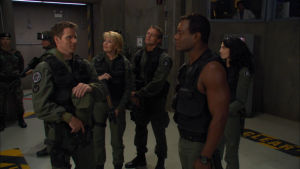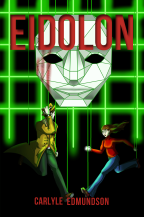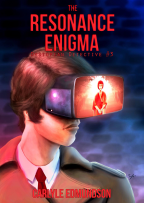4 Continuity glitches (and the funny headcanon to fix them)–Friday Four
- May 8th, 2015
- Posted in Lists
- Write comment
 Sometimes when you’re watching a show, you might notice that there are two bits of the story that don’t quite add up. This is particularly likely when the story arc has been going on for a long time and evolving over the course of the show; things that appeared one way in the beginning were later revealed to be another way, and so on. This tends to result in some complicated continuity, or even outright continuity errors. But just as often, these continuity “errors” can rather easily be fixed with a little explanation provided by the fans, who tend to refer to their personal beliefs about the show as “headcanon.” With that in mind here are some minor continuity problems, and the funny explanations fans use to patch them up.
Sometimes when you’re watching a show, you might notice that there are two bits of the story that don’t quite add up. This is particularly likely when the story arc has been going on for a long time and evolving over the course of the show; things that appeared one way in the beginning were later revealed to be another way, and so on. This tends to result in some complicated continuity, or even outright continuity errors. But just as often, these continuity “errors” can rather easily be fixed with a little explanation provided by the fans, who tend to refer to their personal beliefs about the show as “headcanon.” With that in mind here are some minor continuity problems, and the funny explanations fans use to patch them up.
4. Khan meets Chekov–Star Trek
When Star Trek was picked up for season 2, they made a small adjustment to the cast, adding Chekov to represent how Russia was no longer the enemy in Trek‘s future and to show it hadn’t been destroyed or anything like that. Of course Chekov fit in just fine, and became an iconic member of the Enterprise crew just like everyone else. So iconic, in fact, that people forget he wasn’t around for the first season, including the writers of Star Trek II: The Wrath of Khan. Because you see, when Chekov beams down from the Reliant to Ceti Alpha V, Khan recognizes him. But “Space Seed” is a season 1 episode, before Chekov shows up. So what’s the deal? How does Khan recognize Chekov?
The answer, as provided by Koenig himself: “Chekov kept Khan waiting in the restroom!” It’s a popular bit of fan theory, mostly because it’s a funny joke that deals with another frequently pondered question about Star Trek–where are all the bathrooms? The explanation’s usefulness hinges on the fact that Chekov never got a proper introductory episode. He was just there one day, like he always had been, and that was that. The popular explanation, then, is that he was promoted from a lower position to be on the bridge crew between seasons, and thus had been serving on the Enterprise during season 1 in another capacity. Neatly patches the hole, and usually gets a laugh out of someone.
3. Cam Mitchell Ex Nihilo–SG-1
This is similar to the last example, in that it’s a problem brought about by casting changes. Cam Mitchell was, in his introduction episode at the start of season 9, said to have participated in the battle in Antarctica to protect the Ancient Outpost. He has direct personal contact with our main characters, including Colonel O’Neill, and actually saved their lives. He’s an expert on all of SG-1’s previous missions–and yet we never so much as heard of him, or even someone like him, before the season premiere. So where the hell did he come from?
Well, it just so happens that the season 8 finale involves a lot of time travel. And as a result, they inadvertently create multiple iterations of the timeline. There’s one where SG-1 is stuck back in time and live out their lives in Ancient Egypt, and the present has no Stargate program and the cast leads very different lives. This version of the cast goes back and creates yet another timeline, one that’s close to the “original,” but where O’Neill’s pond has fish in it. Now, there’s no reason that anything they did in Ancient Egypt should directly affect the pond; after all, it’s on another continent. But what that means is that there had to be some both subtle and massive butterfly effects going. Who’s to say that one of these ripples changing the present didn’t lead to Cam Mitchell’s… well, not creation, necessarily, but presence at, and new-found interest in, the Stargate program?
A simple explanation emerges: the reason we didn’t hear of him before season 9 is that he wasn’t present in that timeline.
2. Grayza is Half-Nebari–Farscape
The Peacekeepers in Farscape are initially painted with a Nazi-like dedication to purity in their species. Even just hanging around Crichton was reason to have Aeryn killed in the first episode. And yet, as time goes on, we’re introduced to Scorpius, who’s a full-on half-Sebacean/half-Scarran hybrid. Scorpy is allowed to do what he wants because he’s so valuable to the Peacekeepers, but he’s still a rather glaring exception to the rule. But what if he’s not the only one?
The next big bad to step up on Farscape was Mele-On Grayza. She’s a Commandant of the Peacekeepers, a very high ranking role. But she certainly doesn’t look like any other Sebacean we’ve seen so far. Her skin is pale, an unnatural whitish-gray–unnatural for a human or a Sebacean, anyway. There are other species in the galaxy that are gray, like the Nebari. The Nebari are depicted as possessing a desire for control and order, which is very compatible with Grayza’s primary weapon: the artificially implanted Heppel Oil gland, which emits extremely strong pheromones that give her strong suggestive powers over members of the opposite sex. And if Chiana is any indication, an openness towards sex is also pretty typical of the Nebari (at least biologically; their government, not so much). Thematically, having her be half-Nebari continues this trend that Scorpius began as well, demonstrating the hypocrisy inherent to the Peacekeepers’ positions on purity.
It’s never explained on screen just what Grayza’s deal is; it’s entirely possible that some sebacean-derived species have this weird gray coloration. After all, we did see a number of Sebacean sub-species out there. But making her half-Nebari explains a lot, and it just fits so darn well.
1. The Gallifrey Constant–Doctor Who
In Doctor Who, the Time Lords’ home planet of Gallifrey is occasionally visited by the Doctor and other characters. But what’s interesting is that, for a civilization made up of time travelers, things never really seem to get confusing for them. From what we see of Gallifrey in older serials, there are no River Song-type situations, where people meet each other in the wrong order. Almost every time the Doctor and the Master meet each other, for example, they both seem to know everything that’s been shown on screen between the two of them up to that point (like recently). This is never really explained on the show, and it just plain happens too often and too reliably to be coincidence.
The fan explanation, then, is that all Time Lords are bound to Gallifrey and the flow of time there. If they leave for a year, then they can only return to Gallifrey a year after they left. It seems like a logical precaution, as it keeps people from fooling about, not just in their personal histories, but in the history of the planet as well. And it does have to be some kind of deliberate thing, since the Time Lords are capable of violating it intentionally from time to time (namely, multi-Doctor team-ups). There’s some reason to believe this is the case, since all TARDISes seem to have a connection through the Eye of Harmony. Heck, that might even explain why it’s called the Eye of Harmony–it harmonizes all TARDISes to ensure that temporal shenanigans don’t ensue back on the homeworld. The Doctor and the Master always encounter each other in the proper order because it’s effectively impossible for it to happen any other way.
Since the Eye of Harmony was said to reside on Gallifrey in older serials, it’s not quite clear how it works, what with Gallifrey being sealed off now, but seeing as it has appeared in the revived series, it apparently works all the same.
Are there any amusing or interesting fan theories you know of that patch little holes like these? Any shows I might not be as up on with similar situations? Let me know in the comments, or on Twitter @RetroPhaseShift. As we move into the end of Agents of S.H.I.E.L.D. next week, there’ll be some upcoming schedule shifts as far as posting goes, so stay tuned.








No comments yet.